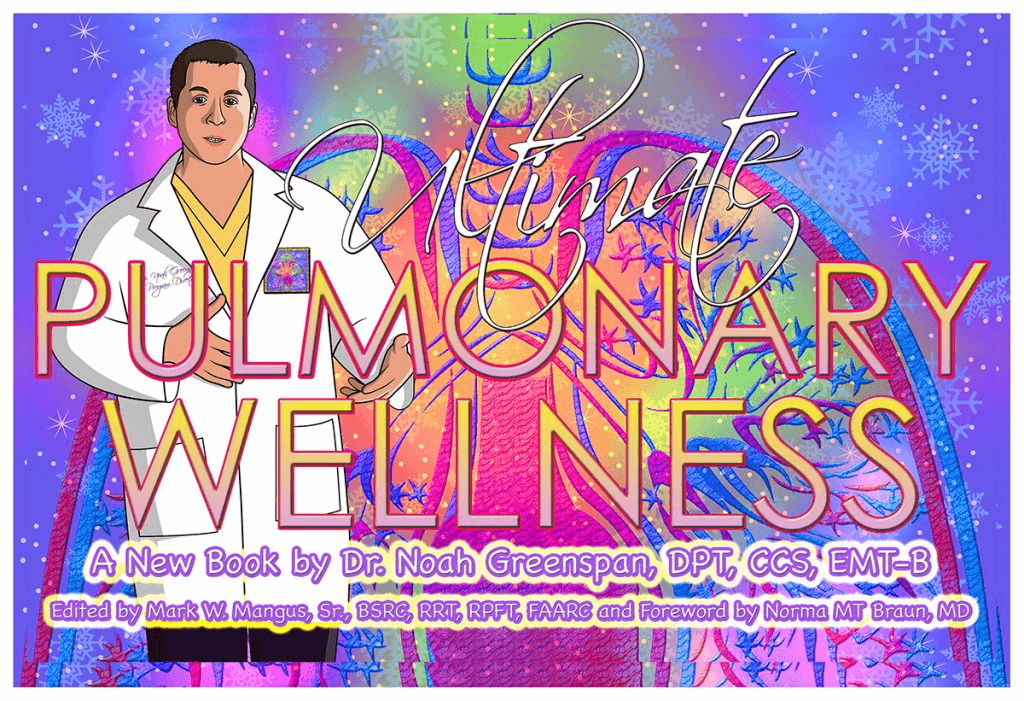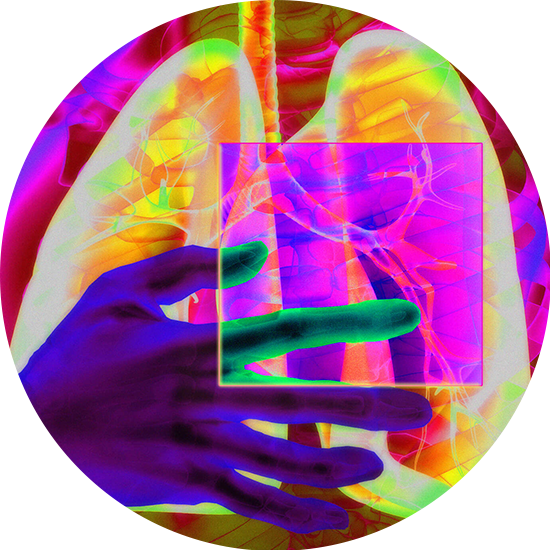
Pulmonary Nutrition
“The doctor of the future will no longer treat the human frame with drugs, but rather will cure and prevent disease with nutrition.” – Thomas Edison
Written with gratitude to my Co-Author, Meredith Liss, MA, RDN, CDN, CDE, CLT
The subject of nutrition will almost invariably be included in any meaningful discussion of health and wellness. In the context of living well with a pulmonary disease, the conversation should be at least slightly (and in many cases, vastly) different than what most of us are used to hearing (and eating). In fact, sometimes recommendations made for the general population, particularly as they relate to cardiovascular diseases, diabetes, and obesity can be in direct conflict with the needs of people living with respiratory conditions.
Before I begin, please understand that this chapter is not a substitute for the medical advice of your physician or a personal consultation with a nutritionist. Instead, this chapter is a compilation of what I have come to believe are the most important principles as they relate to eating (and living) well with a pulmonary disease as well as information that will have the greatest impact on your respiratory system as well as your overall pulmonary wellness.
Like breathing itself, eating and nutrition are multi-factorial processes. The dynamics involved in what, why, and how people eat are many, diverse, and individualized; from physical and physiological, to intellectual, educational, and emotional, to financial and logistical, among many other factors.
As a result, we must first consider the impact that food has on breathing so you can begin to eat intelligently, systematically and in a manner that reasonably fits your lifestyle because if it doesn’t, you probably won’t do it and you won’t be able to sustain it; in which case, these recommendations won’t work. These strategies include thinking about and planning what happens before, during, and after individual meals, over the course of a given day or week and the weeks, months, or years to come.
Also, like breathing, the process of eating and nutrition can be divided into both mechanical and chemical processes. Therefore, I think it will be useful for you to have a basic understanding of the anatomy of the digestive system, particularly as it relates to the mechanics of breathing as well as the classifications of foods and their nutrients as they relate to our body’s chemistry. By understanding these concepts, you’ll be able to organize your eating behaviors to maximize your respiratory health and overall well-being.
I would bet that most people have a general (if not specific) idea of which foods are healthy and which foods are not, which foods will cause us to gain weight and which ones will help us lose weight; and which foods we should eat and which ones we should avoid, as well as which ones we should throw right in the trash.
Despite this basic knowledge, diet and nutrition remains one of the most difficult areas for people to implement and maintain successful and lasting changes in their lives. In the context of pulmonary disease, we also have the added responsibility of thinking about which foods (and other eating behaviors) will make us short of breath.

Nutrition is an extremely important, yet not extremely well understood component of living well with a pulmonary disease. While there is a tremendous wealth of knowledge about nutrition in the management of conditions like cardiovascular disease, diabetes, and obesity; far less is understood about the role of nutrition as it relates specifically to pulmonary health and wellness. This is particularly problematic because what, when, why, and how we eat all exert a tremendous impact on our health in general and our respiratory health and well-being.
As you probably know by now, I am completely biased in favor of exercise as the single greatest behavioral change you can implement to improve your health. However, nutrition comes in a very close second.
In many cases (e.g., someone who is either severely overweight or severely underweight: two common scenarios in pulmonary disease), nutrition can even take center stage as your most important health priority.
Some nutritional issues will have a direct impact on our breathing. Some will be felt immediately, such as the increase in shortness of breath that you might experience after consuming a large meal (or a carbonated beverage or alcohol). Others will have more of an indirect or incidental effect, occurring over a longer period, such as the increased work of breathing that occurs following a 25-pound winter weight gain.
Conversely, not only do eating and nutrition impact your breathing, but breathing can also affect eating and nutrition. For example, being overweight, particularly around the midsection, can increase your shortness of breath. Now, with each breath, your body must lift those extra pounds around your waist. This can make activity more difficult, causing you to become more sedentary. As a result of this sedentary lifestyle, your body will burn fewer calories, causing you to gain even more weight (or at least making the weight more difficult to lose).
As another example, shortness of breath can decrease your appetite or impair your ability to prepare meals, making it a challenge to consume an adequate number of calories. Additionally, many people with respiratory disease are hyper-metabolic, meaning that they burn many times the normal number of calories than the average person. This accelerated metabolism is due to increased frequency (think respiratory rate) and work (think effort or intensity) of breathing.
As you can see, the processes of respiration and eating are intimately related and like many of the other cycles we have talked about, these processes can either work for or against you. My goal is to eliminate some of the mystery behind these relationships and improve your understanding of how you can best help yourself and your body get the most out of what you put in.
Steve Covey, author of The Seven Habits of Highly Effective People, has a great quote: “the main thing is to keep the main thing the main thing.” As healthcare professionals, it is imperative for clinicians to spend an adequate amount of time learning about their patients. This includes understanding both the medical aspects of their disease, as well as getting to know them as human beings. We need to find out about their families, occupations, and personal habits (including what they eat) so we can ensure our patients’ main thing remains the main thing.
As one example, in the context of Ultimate Pulmonary Wellness, many people don’t get enough exercise. Others may be taking their medications incorrectly. For others, anxiety or depression may be their most paralyzing limitation. However, for many of our patients, nutrition is by far, their greatest challenge.
By meticulously getting to know each patient, we can focus on their most important priorities and not waste time on circumstances that do not apply to them. In most people’s situations, nutrition should be included as one of the top priorities.
Basic Anatomy and Physiology of the Digestive System
The process of digestion begins in the mouth, where mastication (a fancy word for chewing) begins to mechanically break down food into smaller pieces. At the same time, enzymes in your saliva begin to chemically break down starches into simple sugars. From the mouth, food passes through the esophagus, which moves it into the stomach through a series of muscular contractions called peristalsis.
This step is very important and can often have a major impact on the respiratory system. The esophagus sits just behind the trachea, where the epiglottis prevents food from entering the trachea during swallowing. However, if the epiglottis is not functioning properly, food and other digestive contents (including stomach acid) can enter the trachea or even the smaller airways and the lungs.
When foreign materials enter the respiratory tract, they can trigger inflammation or obstruction in the pharynx, larynx, trachea, airways, and lungs. For a person who already
has trouble breathing, this reflux can compound their respiratory problem by causing bronchoconstriction (or bronchospasm), increased mucus production or aspiration, when food or other substances are breathed directly into the airways or lungs, potentially leading to inflammation and/or infection.
From the esophagus, food travels through the lower esophageal sphincter into the stomach. The stomach is a hollow organ that churns the food with digestive enzymes and stomach acid. Food is further broken down into smaller and smaller particles and proteins are broken down into their component building blocks, amino acids.
From the stomach, food moves into the small intestine, which is made up of three parts: the duodenum, jejunum, and ileum. In the duodenum, food mixes with bile from the gallbladder (produced by the liver), neutralizing stomach acid and aiding in the digestion of fats. Enzymes from the pancreas also assist in the digestion of proteins, carbohydrates, and complex sugars. Nutrients are absorbed as they pass through the jejunum and ileum, including glucose (sugar), fatty acids, vitamins, and minerals. From the small intestine, waste products pass into the colon (large intestine), where water and minerals are reabsorbed into the blood, producing solid stool (debris and bacteria) for elimination through the rectum and anus.
The Relationship Between Eating and Breathing
Now, let’s introduce a concept that is crucial to your understanding of how to maximize your nutritional status: the relationship between food, eating, digestion—and breathing. As I mentioned previously, some of these issues will directly impact your breathing, whereas others will have a more indirect effect. Some of these factors will be interconnected, and others will be stand-alone issues.
As I see it, the primary issues related to nutrition (food, eating, and digestion); as they affect and are affected by respiratory disease; can be broken down into several major categories. I will address each of them, one by one, and it will be up to you and your healthcare team to decide which issues are most important for you, and which ones may not apply to you at all.
Mechanical Aspects of Eating and Breathing
For the purposes of this discussion, it will be helpful if you think of the upper body as being divided into two separate compartments, similar to a suitcase. The upper compartment, called the thorax or thoracic cavity, houses the heart (within the mediastinum) and the lungs. The lower compartment, called the abdomen or abdominal cavity contains the stomach, liver, gallbladder, spleen, pancreas, intestines, kidneys, and adrenal glands. These two cavities are divided by the dome-shaped diaphragm; the primary muscle of inspiration.
The thoracic and abdominal cavities each have their own internal pressures called intra- thoracic and intra-abdominal pressures, respectively. However, even though they are separate entities, the intra-thoracic and intra-abdominal pressures are intimately related and can directly influence each other. If the pressure in one cavity rises, pressure in the other cavity can also rise (and vice versa).
Again, let’s think back to our suitcase analogy with one side of the suitcase being the thorax and the other side, the abdomen. If you overstuff the thoracic side (as in the case of Emphysema)—the hyper-inflated (overfilled) lungs push downward, compressing the diaphragm and abdominal contents, increasing the pressure on the abdominal side. If you overstuff the abdominal side (as in the case of a large meal or constipation or bloating), the abdominal contents will push upward, resisting diaphragmatic excursion and lung expansion, increasing the pressure on the thoracic side.
Now, here’s where things get interesting. The dome-shaped diaphragm lies between the thorax and the abdomen, sitting directly below the lungs in the thorax and above the stomach and intestines in the abdomen. When you take a breath, the diaphragm contracts in a downward direction, creating a negative pressure in the thorax. This negative pressure is what causes air to rush in, filling the lungs.
When the pressure in the abdominal cavity is increased (e.g. after you’ve eaten a large meal or become bloated with gas), there is increased resistance against the diaphragm’s downward contraction. This puts the diaphragm at a significant mechanical disadvantage, making diaphragmatic contraction more difficult and causing you to feel more short of breath.
In addition, the lungs can get pushed upwards and compressed, further reducing the amount of air that can be taken in with each breath. In an effort to make up for this reduced volume of air, you’re now forced to breathe faster and more shallowly, working harder for each breath. If you recall from previous chapters, the more forcefully you try to breathe, the more airway narrowing, alveolar collapse and air trapping occurs, further increasing your work of breathing and shortness of breath.
Now, here is some further food for thought (pun intended). It doesn’t matter if the obstruction is solid, liquid, or gas: full is full. This means that you have to pay attention to the amount of solid food you ingest, the amount of liquid that you drink and the amount of gas you ingest (or produce). One way that this can occur is by accidentally swallowing air when you eat. However, if fullness and bloating are an issue for you, you should consider limiting carbonated beverages as well as solid foods and liquids known to cause gas.
Chemical Aspects of Eating and Breathing
It is important to realize that not all foods are created equal with respect to their chemical impact on breathing. Each type of food carries a specific chemical load. In particular, it is essential to realize that gram for gram; carbohydrate metabolism produces more carbon dioxide (CO2) than the metabolism of either protein or fat. This is what makes high- carbohydrate meals particularly challenging for people with lung disease. Depending upon the size of the meal, the amount of carbohydrates, and the severity of your disease, results can vary from mild discomfort to acute respiratory distress.
The Respiratory Quotient (RQ) or Respiratory Coefficient is the ratio between the amount of carbon dioxide produced by the body and the amount of oxygen consumed during the metabolism of food. Carbohydrates have an RQ of 1.0. Proteins have an RQ of 0.8, and fat has an RQ of 0.7. In other words, if you eat 1 gram of protein, its RQ of 0.8 would produce only 80% of the carbon dioxide that would be produced by 1 gram of carbohydrate. If you eat 1 gram of fat, its RQ of 0.7 would produce only 70% of the carbon dioxide that would be produced by 1 gram of carbohydrate. In other words, eating a high carbohydrate meal can place a substantially greater workload on the respiratory system due to increased levels of CO2 in the blood.
So, with every strand of spaghetti you eat (slight exaggeration), chemical receptors send a message to your brain that the CO2 level in your blood is high, which, as you may recall, is one of the primary stimuli of respiration. When the CO2 level in your blood rises, the brain sends out chemical impulses telling your respiratory system to breathe faster, deeper, and more forcefully, further increasing the work of breathing and your SOB.
Metabolism: Food as Fuel
Metabolism is a set of life-sustaining chemical processes and reactions that take place in every cell of our bodies. These include the process of digestion—the breaking down of foods into their component nutrients to release and supply energy and other essential substances to sustain all bodily structures and functions.
In the same way that a car needs to refuel every certain number of miles, we continually need to provide our bodies with the necessary nutrients based on the metabolic demands of our daily activities and individual energy use. At the most basic level, we eat in order to provide energy for our bodies to carry out all of the functions of metabolism.
Nutritional Value of Foods
Besides the mechanical impact of food on breathing, it is also important to realize that not all foods are created equal. From a nutritional perspective, it may help to expand on our automobile analogy. In the same way that there are different grades of gasoline that can either enhance or hinder your vehicle’s performance, the foods we eat can similarly affect our functioning. The higher the quality of the nutrients (food) we provide, the more efficiently they can be used and the higher “performance” you can expect from your body in the form of increased energy and activity tolerance and ultimately, reduced SOB.
What Should We Eat?
The Harvard School of Public Health created the Healthy Eating Plate and the Healthy Eating Pyramid. Instead of focusing only on the quantity we eat, Harvard’s Healthy Eating Plate places equal—if not more—emphasis on food quality. In addition, the Healthy Eating Pyramid includes daily exercise and weight control in its core principles, two areas of particular importance for people living with a pulmonary disease.
According to the Harvard group, half of your plate should be made up of fruits and vegetables. A quarter of your plate should be made up of whole grains (not just any grains), and the remaining quarter of your plate should be healthy protein. They also recommend using healthy fats and oils and drinking plenty of water as well as coffee or tea, with no more than 1 to 2 servings of milk and dairy per day.
Please keep in mind that like everything else we discuss, there are caveats and exceptions to all recommendations or suggestions in this text and individual conditions must be applied. Many factors will determine what and how you should eat, including your age, gender, activity level, medical conditions(s), and medication(s). For this reason, rather than give you exact recommendations regarding specific foods and amounts, I’ll present some general principles, which you can further explore with your physician, nutritionist, and other members of your healthcare team. Here is a link to the Harvard HEP:
http://www.hsph.harvard.edu/nutritionsource/healthy-eating-plate
Fruits and Vegetables (1⁄2 Plate)
Fruits and vegetables are high in many essential nutrients and low in fat, sodium, and calories. They also have zero cholesterol. Eating a diet rich in fruits and vegetables is associated with improved pulmonary function and reduced risk of cardiovascular disease (e.g. hypertension, heart attack, and stroke), obesity, type 2 diabetes, osteoporosis and may also protect against certain types of cancers. Fruits and vegetables are also high in fiber, which lowers cholesterol and promotes healthy bowel function. No single fruit or vegetable contains all of the nutrients that you need, so try to eat a wide variety to maximize your nutritional benefit.
Although Harvard’s system suggests a combination of fruits and vegetables to comprise half of your plate, it is preferable—particularly for pulmonary patients—to focus on non- starchy (i.e. low-carb) vegetables, while grouping starchy (i.e. high-carb) vegetables with the grain portion of the plate.
Non-starchy vegetables include (but are not limited to) green leafy vegetables such as arugula, kale, spinach, Swiss chard and watercress, as well as artichokes, asparagus, broccoli, Brussels sprouts, carrots, cauliflower, celery, cucumbers, eggplant, garlic, jicama, leeks, mushrooms, okra, onions, peppers, radishes, red cabbage, scallions, snow peas, tomatoes, yellow squash, and zucchini. Many of these can be eaten raw or cooked.
When we are talking about fruit, we mean fresh or frozen fruit, not juice or dried fruit as these are highly concentrated in carbs (sugars) and therefore, should be limited to two to three servings per day. Here are a few examples of a fruit serving: a small apple, 1⁄2 medium banana, 3⁄4 cup of blackberries, 3⁄4 cup of blueberries, 15 grapes, 1⁄2 mango, 1 cup of melon, small orange, peach, pear, 3⁄4 cup of pineapple, 2 small plums, 1 cup of raspberries, and 11⁄4 cup of strawberries. The greater the variety you include, the healthier. Again, include but do not exceed two to three servings per day.
Whole Grains (1⁄4 Plate)
Grains can be divided into whole grains and refined or processed grains. Whole grains contain the entire grain kernel (bran, germ, and endosperm) plus dietary fiber. Refined grains have been milled to remove the bran and germ, giving a finer texture and prolonging their shelf life. However, the refining process also removes the dietary fiber, iron and many B vitamins—in other words, most of the good stuff.
Whole grains are high in many essential nutrients, including dietary fiber, B vitamins (thiamin, riboflavin, niacin, and folic acid) and minerals (iron, magnesium, and selenium). Eating a diet rich in whole grains can lower cholesterol, reducing the risk of cardiovascular disease, stabilizing blood sugar and lowering the risk of type 2 diabetes and obesity. A diet high in fiber also promotes healthy bowel function and can help prevent blood clots, a known cause of heart attack and stroke. Whenever possible, choose whole grains and whole grain products over processed grains for maximum nutritional benefit.
Whole grains include whole wheat (bread, cereal, or pasta), rye, barley and bulgur, as well as gluten-free whole grains like buckwheat, millet, steel-cut oats, quinoa and brown rice. Many products are made from refined grains including white flour, white bread and white rice. “Enriched” grains have some of the B vitamins (thiamin, riboflavin, niacin, and folic acid) and iron added back but they are still not as healthy as whole grains.
When designating a quarter of your plate for whole grains, pulmonary patients should choose either a portion of whole grains or a portion of starchy vegetables, not both. For example, brown rice or whole-wheat pasta or potatoes or corn and not all of the above.
Healthy Protein (1⁄4 Plate)
Protein can be obtained from both animal and plant sources and is crucial in the composition of bones, muscles, cartilage, skin, hair, and blood as well as enzymes, hormones and vitamins, particularly the B vitamins. Proteins are also high in iron, which is critical in the transport of oxygen in the blood; magnesium, which is essential for building bones and releasing energy from the muscles; and zinc, which is important for fueling many biochemical reactions and boosting immune function.
While protein is essential for a healthy diet, some high-protein foods are healthier than others, so choose your protein sources wisely. Many foods that are high in protein (particularly protein from animal sources) also contain high amounts of sodium and/or saturated (unhealthy) fats. For example, although high in protein, red meat can contain high levels of both sodium and saturated fat. Processed meats (e.g. bacon, sausage, cold cuts) are notorious for being high in sodium and other chemicals often associated with inflammation and chronic diseases.
Therefore, it’s preferable to choose healthy proteins like organic grass-fed beef (which is lower in saturated fat than conventional grain-fed beef), organic eggs, organic skinless poultry and wild-caught fish; and limiting processed meat products.
When it comes to fish, be sure to include at least two meals per week of cold-water fatty fish such as salmon, sardines, herring, or mackerel for the anti-inflammatory benefit of the omega-3 fatty acids. You can also obtain protein from non-animal sources such as legumes (e.g. chickpeas, black beans, lentils), tofu, tempeh, seitan, unsalted nuts or seeds, and nut butters (e.g. peanut, cashew, almond).
Healthy Fats and Oils
Although fats and oils are often viewed as the enemy—leading to obesity, heart disease and a host of other health problems—this is not the case. In fact, healthy fats are cardio- protective, meaning that they actually protect the heart from atherosclerosis and coronary disease. Due to their high calorie content, healthy oils are particularly beneficial for patients who have a difficult time gaining or maintaining weight.
Fats can be classified into four main categories: saturated fat, polyunsaturated fat, monounsaturated fat, and trans-fat or trans-fatty acids.
Saturated fat can raise your blood cholesterol, a known risk factor for heart disease. Therefore, you definitely want to limit the amount of saturated fat in your diet by eating less butter, high-fat cheeses, poultry skin, conventional grain-fed beef and any products made with palm kernel oil.
Polyunsaturated fats include both omega-6 fatty acids and omega-3 fatty acids. Both are essential for our diet. However, it is important to maintain the correct ratio of omega-6 fats to omega-3 fats. The American diet contains excess omega-6 fatty acids because so many processed foods are made with vegetable oils derived from corn, cottonseed, safflower, sunflower, soybean, and “mixed vegetable oils.”
We still need them in our diet, but when consumed in excess, omega-6 fats can trigger or increase inflammation. While this can be beneficial in times of illness or injury, inflammation is associated with increased risk of heart disease, diabetes, arthritis, osteoporosis, cancer, and respiratory disease. For all of these reasons, it is recommended that we increase our intake of anti-inflammatory omega-3 fatty acids while limiting our intake of pro-inflammatory omega-6 fatty acids.
As I mentioned, the main sources of omega-3 fatty acids are cold-water fatty fish such as salmon, sardines, herring, or mackerel. If you are not a fish lover, you can get your omega-3 fats from land sources such as walnuts, ground flaxseeds, chia seeds, hemp seeds, canola oil and green leafy vegetables. You can also consider taking a supplement, which will be addressed later in this chapter.
When it comes to fats and oils, the bottom line is to enjoy foods rich in monounsaturated fats such as avocado, unsalted nuts and nut butters, seeds, olives and olive oil.
Finally, trans-fats or trans-fatty acids are man-made fats. However, as of June 15, 2015, they have been taken off the FDA’s Safe List and should be avoided at all costs. Trans- fats can be found in foods like margarine, commercially fried foods and baked goods made with either shortening or partially hydrogenated vegetable oils.
Dairy and Bone Health
Dairy products are a good source of calcium, vitamin D and potassium, and yogurt is an excellent source of probiotics, which are beneficial to digestive health. My gut feeling (pun intended) is that probiotics and the overall health of our gut also play a key role in reducing inflammation and boosting our immune function. However, according to the Harvard group, while calcium is important for building and maintaining healthy bones, there may be other sources that may be healthier and lead to fewer associated health risks. If you do plan to use dairy, replace whole milk, yogurt, and cheese with low-fat or fat- free products and limit their use to a maximum of one to two servings per day.
If you take or have taken steroids, you may be at increased risk for bone loss (i.e. osteopenia and osteoporosis). Therefore, it is important to pay attention to your intake of calcium and vitamin D (which aids in calcium absorption) and magnesium (to prevent any negative side effects of calcium).
Calcium-rich foods include dark green, leafy vegetables, canned sardines with bones, canned salmon, black-eyed peas, yogurt, cow’s milk, cheese, calcium-fortified nut milks, and firm tofu. Adults ages 19-50 require 1000 mg per day. When women turn 50 and men turn 70, the requirement increases to 1200 mg daily.
Foods rich in vitamin D include salmon, tuna, sardines, eggs, fortified milk, and yogurt. Magnesium-rich foods include spinach, black beans, pumpkin seeds, almonds, cashews, soymilk, peanut butter, avocado, whole grain bread, brown rice, yogurt, salmon and milk.
Dairy and Mucus Production
For as long as I can remember, people have been claiming that dairy products increase mucus production. I’m not going to make a case as to whether I think they do or don’t. I will, however, remind you that everyone is different. So, if you feel that dairy products increase your mucus production, avoid them.
However, many people with COPD and other conditions in which mucus is a problem are able to tolerate at least some dairy. If you want to include dairy products in your diet, I wouldn’t just accept the fact that you can’t just because people have said so. This is particularly important for people who might be prone to calcium or vitamin D deficiency, including anyone who has been on steroids or who has additional protein needs due to muscle loss or weakness. Also, don’t forget the probiotic benefits of yogurt for anyone who has taken antibiotics.

Not all dairy products are created equal. Most people find that skim products are easier to handle than whole dairy, but my suggestion would be to try them if you like them and see how you react (unless you are lactose intolerant or allergic). Also, start slow. Instead of drinking a quart of milk, try a sip or two or a couple of spoonfuls of yogurt. If you tolerate this amount, you can gradually increase your “dosage.”
Maintaining a Healthy Weight
Keeping your body at a healthy weight is extremely important and should be included in any discussion regarding the optimal management of pulmonary disease and health in general. This includes maintaining a normal weight versus being either over- or underweight as well as promoting good body composition (the percentages and ratios of body fat, lean muscle, bone, and water). As you probably realize, not all body weight is created equal.
To many, it may seem like being overweight or underweight are simply equal but opposite problems. If you’re overweight, you simply need to eat less and get your butt off the couch and if you’re underweight, I’m sure at some point, you’ve had to suffer the indignity of someone telling you how “lucky” you are because “you can eat anything you want and not gain weight.”
However, simply losing or gaining weight is not actually simple at all. In fact, it can be extremely complex, especially in the context of pulmonary disease. In addition, sometimes your ability to lose or gain weight can be completely unrelated to anything you eat or don’t eat or any exercise you do or don’t do.
For example, if you’ve ever had to take steroids, you know prednisone can cause you to gain weight, particularly around the face and midsection. And for those of you who spend a good amount of your day gasping for air, you already know what it feels like to run a marathon—every day! While being overweight can have a significantly negative impact on your respiratory mechanics and your disease, being underweight is often a negative consequence of your disease.
If you have pulmonary disease and have either tried to lose weight or gain weight, you probably know that doing either one requires a sound (scientific) plan and a very healthy dose of willpower. Wouldn’t it be great if those who are overweight could simply “donate” those extra pounds to those that are underweight? Of course, the situation is not always this cut and dried but let me explain further.
The Overweight Patient
As I mentioned earlier, being overweight can have a profoundly negative impact on your respiratory mechanics and increase your work of breathing. However, depending on the amount of excess weight, the problem can range from being a minor annoyance (if you are five or ten pounds overweight) to literally being the difference between life and death. I often see patients who are 25, 50, or even 100+ pounds overweight. If you are more than 25 pounds overweight, weight loss is unquestionably your highest priority and without a concentrated effort to lose the weight, it will be virtually impossible for you to achieve your full potential.
In addition to how much excess weight you are carrying, where your weight sits on your body can also have a major impact on breathing. In particular, excess weight around the abdominal area will make breathing more difficult, forcing you to lift that excess weight with every breath. Think of it as weightlifting for your respiratory muscles. Is it any wonder why you’re more fatigued?
Often, patients come to me with reports of increased shortness of breath even though their pulmonary function has remained stable. In fact, not much has changed at all except that they are now 15, 20, or 25 pounds heavier than the last time I saw them. Think of those extra pounds as two bowling balls pulling down on your thorax every time you need to take a breath. Being overweight contributes to increased shortness of breath, low energy and decreased activity tolerance. Often, if patients can manage to lose the extra weight, their breathing problems improve dramatically.
When it comes to losing weight, exercise alone will not do it. Exercise is a major part of weight loss, but diet is at least equally if not more critical. In fact, I often tell my patients that they have the ability to out-eat any exercise program we give them. The healthiest strategies will include a combination of both healthier eating and increased physical activity.
The Underweight Patient
The underweight patient faces a completely different set of challenges. Due to increased work and frequency of breathing, the body’s metabolic (and caloric) demand can increase dramatically. I don’t believe the “10 times that of a normal person” that I’ve been hearing lately, but the difference in metabolism is significant compared to someone who is not constantly struggling to breathe. If weight loss progresses far enough and the person does not have sufficient fat stores, they will begin to burn muscle tissue for fuel. By the time the body reaches this point, the patient is often too weak to carry out even the simplest daily activities. Unfortunately, once you get to this point, their overall prognosis is poor if they cannot reverse this process.
Caloric Value of Food
From a caloric perspective, both protein and carbohydrates contain 4 calories per gram as compared to fats, which contain 9 calories per gram and alcohol contains 7 calories per gram. This makes calorie-dense (but healthy) fats a friend to the person trying to gain weight. Do not increase your alcohol intake as a weight-gain strategy unless you don’t plan on getting much done. In addition to harming your liver, I’m sure you can see how this choice could lead to a whole host of other problems.
Now, let’s take it one step further. A pound is made up of approximately 3500 calories. This means that in order to lose or gain one pound, you must either create a deficit of 3500 calories or a surplus of 3500 calories, respectively. In other words, if I consume 3500 fewer calories than I burn, I can reasonably expect to lose one pound. Conversely, if I consume 3500 calories more than I burn, I can expect to gain one pound.
Therefore, if your goal were to lose one pound per week, you’d need to create an average deficit of 500 calories per day (7 days per week x 500 calories per day = 3500 total calories). If your goal were to lose two pounds per week, you would need to create an average deficit of 1000 calories per day (7 x 1000 = 7000). This can be accomplished either by burning extra calories by increasing your exercise or activity, or by reducing your caloric intake by eating smaller portions or less calorie-dense foods. As I mentioned previously, a combination of both is more effective than either strategy alone.
Conversely, if your goal were to gain one pound per week, you’d need to create an average surplus of 500 calories per day. If your goal were to gain two pounds per week, you’d need to create an average surplus of 1000 calories per day. In the case of pulmonary patients, decreasing your activity is not recommended at all. Neither is increasing the size of your individual meals (which may not even be possible).
For all of these reasons, gaining weight is often even more challenging for the underweight person than losing weight is for the overweight person. If you are underweight, it is crucial that you utilize strategies to increase your caloric intake by eating as much calorie-dense (but still healthy) food as you can in a way that will not significantly impair your breathing.
Many factors contribute to weight changes and there are no absolutes. So, instead of thinking of this as a hard and fast rule, use this mathematical approach to calories as a rough guideline. Make any necessary adjustments based on your own individual experiences and the recommendations of your healthcare team.
Hydration and Fluid Balance
Maintaining adequate hydration is important for everyone, but it is particularly crucial for people with pulmonary disease. Firstly, every part of the respiratory tract requires moisture to do its job effectively. In addition, hydration is important for thinning out your secretions, (mucus) keeping it moist, and allowing it to be expelled more easily. When we are dehydrated, our mucus becomes thicker and stickier, making it more difficult to expel and making you more prone to infection.
Many people have difficulty getting adequate hydration during the day for a variety of reasons. These can include anything from “I don’t like water” to “the more I drink, the more I pee,” among others. If you are not naturally a big water drinker, I know you’re not going to go from drinking zero glasses of water to drinking the “recommended” 8-10 glasses per day. However, try to aim for a minimum of 4-5 glasses per day. A good indicator that you are getting enough fluids is that your urine is clear and colorless. People who are dehydrated often have highly concentrated, dark yellow or cloudy urine.
Also, when we talk about getting enough fluids, other drinks besides water count toward your overall fluid goal. In fact, if you are trying to gain weight, you should avoid drinking a lot of water since it fills you up without the benefit of having any calories. Instead, opt for calorie-containing beverages such as non-fat milk, a smoothie or low or zero-carb protein drink to maximize your caloric intake without increasing your carbohydrate load.
Also, don’t drink before or during your meals. This can fill you up and prevent you from getting adequate calories and nutrition from your food. If lack of appetite or a feeling of fullness is an issue, you can get some of your fluids in the form of fruits, vegetables, and soups. Just be careful though, because many soups contain a lot of sodium.
Conversely, people who are trying to lose weight should opt only for plain water or other non-caloric beverages whenever possible. You would be amazed at how many extra calories can be consumed in the form of caloric beverages. In addition, drinking water before or during a meal will make you feel fuller, allowing you to eat less and reducing your overall caloric intake.
IMPORTANT: Some people have to be careful about consuming too much water. This includes people with renal (kidney) disease, heart failure and those taking diuretics, among others. While it is still important for these patients to remain hydrated, they should discuss their particular fluid requirements and restrictions with their physician.
Alcohol
When it comes to alcohol and cardiopulmonary disease, there are several considerations for you to be aware of. First, alcohol is a mild diuretic and increases the production of urine, making you pee more frequently. It also has a negative fluid impact, meaning if you drink one cup of alcohol, you lose more than one cup of fluid. Therefore, if you are going to drink alcohol, make sure that you are drinking extra (non-alcoholic) fluids to replace those flushed from your body to avoid becoming dehydrated (or too drunk).
Alcohol is a central nervous system depressant that lowers your heart rate and makes you breathe slower and more shallowly. Therefore, depending upon the condition of your lungs (and how much you drink), alcohol can make breathing more difficult, even causing respiratory distress or failure.
Also, alcohol can interact with your medications including prescription drugs, over the counter (OTC) drugs and nutritional supplements, potentially increasing the effects of some and making others less effective or not effective at all. Again, if you are going to drink alcohol, check with your doctor to determine if and how much is safe for you.
Finally, men and women metabolize alcohol differently. As a general rule, men should limit alcohol to a maximum of two drinks per day, and women should consume no more than one drink per day. Now, before you start looking for that 64-ounce beer mug from college, one drink means 5 ounces of wine, 12 ounces of beer, or 11⁄2 ounces of liquor. (Sorry, sports fans.)
Please understand that I am not trying to scare you, nor am I trying to convince you to become a teetotaler. I’m not. All I am saying is to use common sense. Be aware of the effects of alcohol on your body, and if you do decide to drink, moderation is the key.
Caffeine
Caffeine is a central nervous system stimulant, potentially increasing your heart rate, blood pressure and respiratory rate. This is particularly important for pulmonary patients because their hearts are often already working harder due to the increased work of breathing. In addition, certain classes of pulmonary medications—beta-2 agonists in particular, can also be stimulants. Therefore, when used in combination, the two can make you feel jittery, anxious or shorter of breath in addition to difficulty sleeping. Stimulants can also increase your risk of cardiac arrhythmias like tachycardia (fast heart rate) or atrial fibrillation, among others.
Sodium (Salt)
Unrefined salt provides two elements essential for life, sodium and chloride. The American Heart Association recommends 1500 milligrams of sodium (or less) per day. However, while sodium is an essential nutrient, the average American often consumes more than double that amount and although seemingly harmless, most people don’t understand the potential danger of an over-intake of salt.
Think back to our early discussions about the body maintaining equilibrium. This is true of the body’s salinity (sodium level) as well. If you eat too much salt, your body will retain additional fluid to dilute the amount of sodium in your blood. This increased fluid retention can lead to an increase in blood pressure, causing the heart (particularly the left ventricle) to work harder. If left untreated over time, the ventricle can increase in overall size and thickness, requiring more oxygen to supply its increased muscle mass.
If the left ventricle cannot meet this excess demand (overload), fluid can back up into the pulmonary circulation, causing increased shortness of breath. This is known as left-sided or congestive heart failure. Left unchecked, blood can continue backwards through the pulmonary circulation to the right side of the heart, eventually pooling in the lower extremities (pedal edema). This is what is known as right-sided heart failure. The bottom line is “easy on the salt!”
Instead of salt, use onions, garlic, herbs, spices, citrus juices, and vinegars to flavor your food. Experiment with basil, curry, dill, oregano, paprika, parsley, rosemary, sage, thyme, turmeric and other salt-free flavorings.
Minimize your use of high sodium foods such as smoked, cured, salted, or canned meat, fish or poultry (including bacon, cold cuts, ham, hot dogs, sausage, caviar and anchovies). Opt for fresh or frozen vegetables instead of canned (high in salt). Drain and rinse canned beans and choose low-sodium versions of canned soups. Also, choose unsalted nuts and seeds.
Food Allergies and Sensitivities
Often, people with respiratory disease also suffer from food or other allergies, which can have a negative impact on both the upper and lower respiratory tracts as well as your body’s overall inflammatory and immune responses. Food allergies occur when your body’s immune system overreacts to a food or substance that it mistakenly perceives as a threat.
Food allergies can range from mild to life threatening (anaphylaxis). The most common manifestation of food allergies is chronic rhinitis or inflammation of the mucus membranes in the nose, but food allergies can also impact the respiratory system in the form of shortness of breath, cough, tightness in the throat or difficulty swallowing, wheezing, airway obstruction and swelling of the lips, face and tongue.
You may be surprised to hear that 90% of all dietary allergies are caused by 8 foods. These include eggs, milk and dairy products, peanuts, tree nuts (pecans, walnuts, almonds), fish, shellfish (shrimp, crab, lobster), wheat or gluten and soy. People with specific food allergies may also react to similar or related foods. The severity of symptoms is generally associated with the amount of the allergen ingested, but as a general rule, it is best to eliminate the offender from your diet completely.
Gas and Bloating
Excessive gas and bloating can also create problems for people with respiratory disease. Again, think about everything that takes up space in your stomach, increasing the intra- abdominal pressure. Remember, your body doesn’t care if this increased pressure is due to solid, liquid or gas. If gas or bloating is a problem for you, consider limiting or avoiding gas-producing foods and carbonated beverages. As an alternative, you can try using an enzyme-based, gas-reducing food additive like Beano.
Fiber
Fiber is a form of carbohydrate that regulates blood sugar, promotes the passage of food through your system and may help prevent many chronic diseases. Constipation can increase intra-abdominal and intra-thoracic pressures, making breathing more difficult. We should try to eat 20 to 30 grams of fiber per day in the form of whole grains, fruits and vegetables and beans. If gas and bloating are a problem for you, low-FODMAP, fiber-rich foods include oatmeal, oat bran, brown rice, rice bran, chia seeds, flax seeds, strawberries, blueberries, oranges, spinach and quinoa.
Gastroesophageal Reflux Disease (GERD)
Often, people with respiratory disease also suffer from another condition called Gastro- Esophageal Reflux Disease (GERD). Many are not even aware of it (silent reflux) but GERD can actually cause, trigger, or worsen their respiratory condition (and vice versa). Often, once GERD is discovered and treated, their respiratory condition improves as well.
GERD is caused when acid backs up from the stomach through the lower esophageal sphincter, damaging the esophagus, throat, and possibly, the airways and lungs. While the most common symptom of acid reflux is heartburn, GERD can also cause a sore throat, bitter taste in the throat and mouth, chest discomfort (non-cardiac) and abdominal pain, as well as many “respiratory” symptoms such as coughing, wheezing, and shortness of breath.
The exact cause of acid reflux and GERD is unknown but several factors contribute to or exacerbate the problem, including obesity, diet (particularly fried, fatty, spicy, and acidic foods like citrus and tomatoes), caffeinated beverages and chocolate and mint flavorings. Drinking alcohol or cigarette smoking can also exacerbate the problem, as can certain medications including antihistamines, calcium-channel blockers, nitrates and theophylline, sometimes used to treat pulmonary disease. Consuming large meals or eating close to bedtime can also contribute to GERD. Finally, GERD can result from other medical conditions like hiatal hernia, pregnancy, rapid weight gain and diabetes, in particular.
Lifestyle modifications for people suffering from GERD include weight loss, dietary modifications (e.g. avoiding known triggers, eating smaller and more frequent meals and not eating or drinking close to bedtime). Quitting smoking and minimizing alcohol intake are also recommended.
Elevating the head of your bed by 6-12 inches (or sleeping with a wedge) can help reduce symptoms. Pharmaceutical and surgical options are also available but are beyond the scope of this text and should be discussed with your physician.
Nutritional Supplements
First and foremost, it is important to understand that vitamins and minerals are best utilized if you get them as part of a healthy, balanced diet. Be sure to include foods rich in antioxidants such as vitamin C (red pepper, green pepper, papaya, strawberries, broccoli, oranges, cantaloupe), vitamin E (sunflower seeds, almonds, hazelnuts), selenium (Brazil nuts, tuna, sardines, salmon, sunflower seeds), and carotenoids (carrots, sweet potatoes, red peppers, spinach, cantaloupe, kale, collard greens, mango, butternut squash).
If you have difficulty getting all of your vitamins from food, you may want a little extra insurance. Choose a complete, age-adjusted multivitamin that contains 100% of what you need but not more and take it either once daily or every other day. Avoid the MEGA- vitamins as too much of a good thing will either wind up in your toilet bowl in the form of very expensive urine, or worse, cause harm. Speak to your physician or nutritionist about the right type and dose of supplements for you.
As we discussed, calcium, vitamin D and magnesium are important for bone health, especially if you are at increased risk for osteoporosis or have been on steroids. Again, do not go above the recommended daily dose and when taking a calcium supplement, be sure that it also contains vitamin D and magnesium. If your vitamin D level is low (get it checked!), you can supplement with additional vitamin D3.
Finally, a high-quality omega-3 fish oil supplement is beneficial due to its cardio- protective and overall anti-inflammatory properties. Choose a fish oil supplement with a decent dose of both eicosapentaenoic acid (EPA) and docosahexaenoic acid (DHA). Don’t be fooled by supplements that boast 1000 mg of fish oil; you need to make sure you are getting actual DHA and EPA as other oils are sometimes included in the 1000 mg of “fish oil.” Compare labels and choose supplements with high amounts of these two beneficial fatty acids.
For herbal and homeopathic remedies, I strongly suggest carefully evaluating them on a case-by-case basis with your doctor, nutritionist or pharmacist, especially as they may affect your medical condition and medications.
Tips for Eating for Pulmonary Patients
- Avoid large meals. Instead of 2-3 large meals, eat 5-6 smaller “feedings” per day. In other words, eat frequently (roughly every 2-4 hours, depending on your goals) but in small quantities so that the food you eat doesn’t take up all of your available breathing space.
- If decreased appetite is an issue or you are trying to gain weight, drink at the end of your meal as opposed to before or during.
- If you are trying to lose weight, drink water before and during your meal.
- During the meal, pace yourself and use pursed-lip breathing.
- If shortness of breath is an issue, use your rescue inhaler 15 minutes before eating.
- If you use supplemental oxygen, wear it while you eat.
- If secretions are a problem, clear your airway before eating.
- Keep a food diary to monitor the impact of different foods on your breathing and energy levels.
- Eat mindfully, not mindlessly.
Keeping a Food Diary
Write everything down that you eat and drink including time, how much you ate and how you felt afterwards. Take note of food’s impact on your shortness of breath and energy levels and record those in your diary. Observe how your body reacts to different foods with respect to type, amount and timing. Keeping a diary will also make it easier for your physician or nutritionist to understand your needs and offer the most effective advice.
I often say: “if you want to change your life, you have to change your life.” That is, if you want to see significant results, you need to make a significant change. Changes that don’t require any discipline will not lead to the changes that you want. A coordinated effort and a little willpower will help you find and stick with a nutrition program that fits your lifestyle and your health needs.
Order Your Book Now!

Purchase Your Signed Copy Today!
- Within the United States: $27.50 including Postage and Handling!
- Outside of the US: $52.00 including Postage and Handling! (Sorry. We know that is more than the cost of the book but we cannot ship for less.)
Subscribe To Our Newsletter For Upcoming Offers
- Be the first to know about new webinars, exclusive offers, and podcasts.























